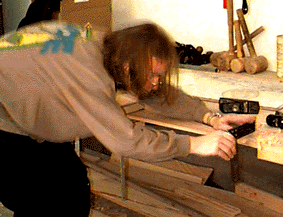Boat Building Tools From the Nineteenth Century
to the Twentieth Century
Researching tools of the nineteenth century brought forth this quotation:
"The researcher only sees what he is looking for, and only looks for that
which falls within his own specific fields of interest." (Wyllie, Robin H.
"French Maritime Provinces" The Chronicle)
I have learned through my research and interviews that the boat building
tools of the nineteenth century are not much different from the tools used
by carpenters of the nineteenth century. I interviewed three people: E. J.
Gaudet, D. Taylor, and Gordon Swift, on their knowledge of tools and boat
building.
 I asked Gordon Swift what some of the tools used for boat building were,
he said, "Maybe some of the old wooden planes." D. Taylor suggested an adze,
and E. J. Gaudet gave his two cents by suggesting, "Rabbet planes which were
mostly used on boats, and a compass plane to cut out parts." Rabbet planes
were used to cut corner grooves into wood. Through my research I found nothing
that proves E.J. wrong or suggests that he is right, but since he is a boat
builder with the experience of his own boat, and experienced in building
the Whale Boat, I respect his opinion as a nineteenth-century boat builder.
I asked Gordon Swift what some of the tools used for boat building were,
he said, "Maybe some of the old wooden planes." D. Taylor suggested an adze,
and E. J. Gaudet gave his two cents by suggesting, "Rabbet planes which were
mostly used on boats, and a compass plane to cut out parts." Rabbet planes
were used to cut corner grooves into wood. Through my research I found nothing
that proves E.J. wrong or suggests that he is right, but since he is a boat
builder with the experience of his own boat, and experienced in building
the Whale Boat, I respect his opinion as a nineteenth-century boat builder.
Hand planes were one of the most popularly used tools for boat building
of the nineteenth century. The planes cut joints out, smoothed parts of the
boat, and also helped give shape to parts such as the oars. The average number
of planes owned by the "old time craftsman'' is about fifty. More then likely
four other craftsmen had owned the same plane.
The more commonly used planes were the modeling plane, smoothing plane,
rabbet plane, jack plane, long or trying plane, jointer or floor plane, and
the cooper's long jointer. These planes cost anywhere from twenty-five cents
to ten dollars and fifty cents.
 From my researching I have found that a Shipwright's adze, which is also
called the American adze, is the only tool that they used in the nineteenth
century that we don't see much of today. An adze is a tool somewhat like an
axe but with a blade set across the end of the handle and curving inward.
This was use to gouge out large pieces of wood from beams or logs. It was
also used to carve out the stem of the boat (the stem is the front of the
boat where the planks on the side of the boat connect), along with smoothing
out and shaping the structures.
From my researching I have found that a Shipwright's adze, which is also
called the American adze, is the only tool that they used in the nineteenth
century that we don't see much of today. An adze is a tool somewhat like an
axe but with a blade set across the end of the handle and curving inward.
This was use to gouge out large pieces of wood from beams or logs. It was
also used to carve out the stem of the boat (the stem is the front of the
boat where the planks on the side of the boat connect), along with smoothing
out and shaping the structures.
The chisel is another tool that was commonly used by the boat builder.
Chisels were used for chipping out the stem, shaping the oars and oar handles,
scraping off glue, and other small odd jobs. The average old-time craftsman
owned approximately seventeen different sizes and shapes of chisels and each
one of these chisels is to have had four previous owners. A slick is a chisel
much larger in size that is razor sharp and never struck but pushed by the
hands and shoulders. The slick was used to shave off large pieces of unwanted
wood from the boat.
Boat builders needed and used clamps often. They used the clamps to hold
sections of the boat together while the glue dried, or to hold a board in
place while they worked on it. The average number of clamps owned was seven
(believe it or not) and they were also more then likely to have four previous
owners.
Screwdrivers, yes screwdrivers, this was not the primitive times we had
screws and screwdrivers. They were the same basic models we have today, only
then the handles were wooden and the metal was different. Nowadays it is
more common to see a plastic handle on a screwdriver than a wooden one. The
average number of screwdrivers owned was two and each had two prior owners.
The handsaw was another commonly used tool for boat building. The handsaw
was used to cut wood off at certain angles and to cut wood to length. The
average number of saws owned was eight and the saws may have had four previous
owners.
Boat building tools have changed a lot since the nineteenth century, but
they still have the same basic uses and form. Most chisels today have plastic
handles not wooden ones and slicks aren't used as often. Planes are now made
with some plastic and different kinds of metals instead of wood. Their use
is the same but now a handle is stuck onto them and they are made out of
a few different materials. The handsaw's handle may have changed, but the
changes just make it easier to use.
In the opinion of boat builder Gordon Swift, tools have changed to make
them cheaper to construct and faster to print out, that is, cost-effective.
According to E.J. Gaudet "We have harder materials and diamond carbide blades.
Things have changed to make tools lighter, smaller, and easier to use." Dave
Taylor's opinion is that it is "to make things more cost-effective."
In the opinion of this reporter, tools have changed to make their uses
easier for us, but not all tools have the quality as they used to. The tools
of the nineteenth century were made to last; they weren't like the disposable
diapers we use today. Not everyone had a lot of money and could afford to
buy a new tool every time something went wrong. Each tool was around until
there was no way it could be fixed or used for anything. Today, companies
who make their tools cost-effective are making the ones of lesser quality.
 I asked Gordon Swift what some of the tools used for boat building were,
he said, "Maybe some of the old wooden planes." D. Taylor suggested an adze,
and E. J. Gaudet gave his two cents by suggesting, "Rabbet planes which were
mostly used on boats, and a compass plane to cut out parts." Rabbet planes
were used to cut corner grooves into wood. Through my research I found nothing
that proves E.J. wrong or suggests that he is right, but since he is a boat
builder with the experience of his own boat, and experienced in building
the Whale Boat, I respect his opinion as a nineteenth-century boat builder.
I asked Gordon Swift what some of the tools used for boat building were,
he said, "Maybe some of the old wooden planes." D. Taylor suggested an adze,
and E. J. Gaudet gave his two cents by suggesting, "Rabbet planes which were
mostly used on boats, and a compass plane to cut out parts." Rabbet planes
were used to cut corner grooves into wood. Through my research I found nothing
that proves E.J. wrong or suggests that he is right, but since he is a boat
builder with the experience of his own boat, and experienced in building
the Whale Boat, I respect his opinion as a nineteenth-century boat builder.
 From my researching I have found that a Shipwright's adze, which is also
called the American adze, is the only tool that they used in the nineteenth
century that we don't see much of today. An adze is a tool somewhat like an
axe but with a blade set across the end of the handle and curving inward.
This was use to gouge out large pieces of wood from beams or logs. It was
also used to carve out the stem of the boat (the stem is the front of the
boat where the planks on the side of the boat connect), along with smoothing
out and shaping the structures.
From my researching I have found that a Shipwright's adze, which is also
called the American adze, is the only tool that they used in the nineteenth
century that we don't see much of today. An adze is a tool somewhat like an
axe but with a blade set across the end of the handle and curving inward.
This was use to gouge out large pieces of wood from beams or logs. It was
also used to carve out the stem of the boat (the stem is the front of the
boat where the planks on the side of the boat connect), along with smoothing
out and shaping the structures.